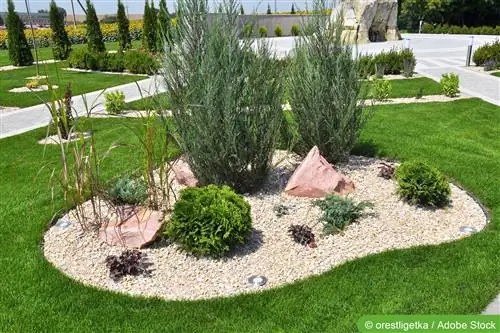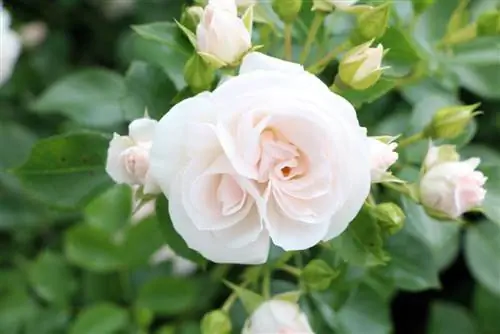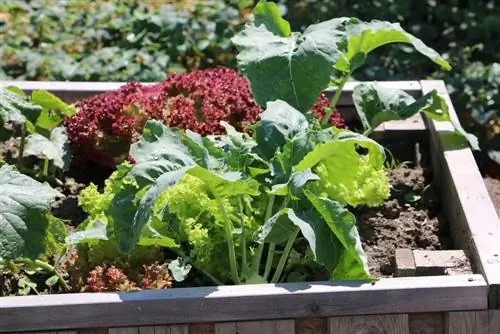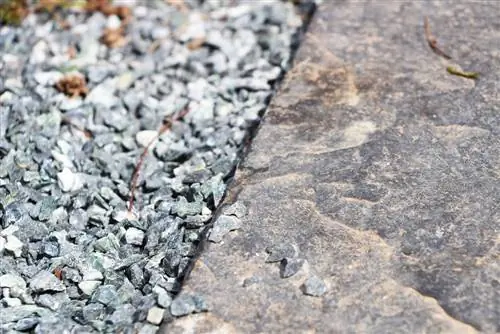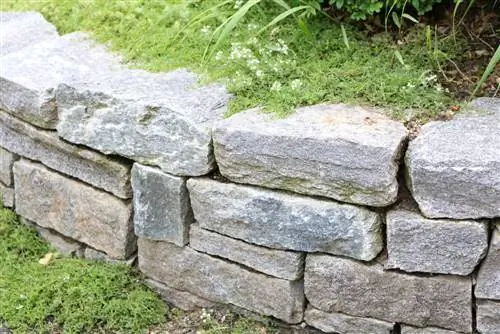- Author admin [email protected].
- Public 2023-12-17 03:39.
- Last modified 2025-01-24 12:45.
The gravel or stone bed is often found in the entrance area to the house and is intended to leave a well-kept impression on neighbors or other people passing by and thus cast a positive overall picture of the entire garden.
Basics for designing a stone bed
The hobby gardener has almost no limits when it comes to designing the stone or gravel bed. Depending on the size and location of the stone bed and the desired effect, different colored stones can be used to create patterns or entire lettering. In a classic stone bed, only white decorative stones are used, such as:B. decorative chippings, decorative gravel or even decorative sand. However, every hobby gardener can decide for themselves and design their own personal stone bed according to their ideas in terms of the size and color of the stones. Individual plants or even small bushes or trees can be placed between the stones, which contribute to a rounded overall appearance of the bed.
For larger beds, the gardener can even install paths marked by stone tiles that allow him to reach certain plants integrated into the bed so that he can water them. A sunny location should preferably be chosen for the stone bed so that the stones can dry quickly after a rain shower. It is particularly eye-catching if the bed is slightly slanted or runs over different steps. Significantly larger stones should be used to design the steps so that the transition looks aesthetic at the end. To stimulate the imagination, the hobby gardener can get some ideas from renowned gardening magazines and connect them with his ideas.
Construction of the gravel bed
The area of the ground that is to be used as a gravel bed in the future must first be loosened up a bit. If you live in an area where the soil is clayey, you can be sure that rainwater and irrigation water are drained well from the ground and that there will be no waterlogging. If you are not sure about the nature of the soil or if it only has a low clay content, you should remove some of the top layer of soil. The horror of every stone bed is weeds.
If you make the effort and put a lot of work into a beautiful and well-maintained bed, then you also want this beautiful view not to be destroyed within a few months and the bed to become overgrown with weeds. Therefore, a special weed fleece is laid underneath the stones, which should completely curb the growth of unwanted green plants. The previously selected gravel, sand, grit or stones are then placed on top. It should already be clear at this point where which plants will later be planted, so that some space can be left in these places. Even if the hobby gardener has decided to lay a path over stone slabs through the bed, he should leave enough space in the affected areas.
Suitable plants
All plants that cope well with clay-rich soil are suitable for planting the stone bed. In addition, the plants should not have any problems with higher temperatures. Especially in summer, when temperatures reach well over 30 °C and there is no rain for several days, the stones heat up, so that there is actually a slightly higher temperature directly above the earth's surface. Particularly popular and easy-care plants for creating a stone bed include alyssum, thistle, pansies, pasque flowers, but also roses and carnations. Stone beds are just as suitable for planting Mediterranean herbs. Small seedlings should always be planted, as sowing seeds will most likely not be successful due to the weed fleece laid out.
Care and cleaning of the stone bed
- Most cleaning work is required on the stone bed, especially in autumn: fallen branches and leaves spoil the overall appearance of the bed and should be removed as quickly as possible.
- In phases in which it is cool and damp for a longer period of time, there is a risk that lichens and mosses will form on the stones and the well-kept impression will inevitably be lost.
- If the stone bed is a manageable area and larger pebbles have been used, the best way to deal with moss infestation is to wipe the stones individually or sieve them.
- If there is repeated strong moss formation, the stones can also be treated discreetly with a little weed killer.
- Otherwise, the care is relatively manageable: the rain washes off the stones and the sun dries them again.
Further expansion into a rock garden
Once you have created a stone bed as a hobby gardener and had a lot of fun doing it, you can consider whether the individual stone bed should be integrated into an entire rock garden. The prerequisite for this is, of course, that the home garden has the necessary space. A small green area bordered by the stone bed and adorned with a few bushes also spices up the garden. Maybe you can even create a small pond with a few fish. Or a narrow path is laid through the stone bed to a hut in the garden, which ideally has a barbecue area or a pizza oven. The beautiful garden is not only an eye-catcher for people walking past, but also offers an idyllic place where parties can be celebrated within the family or within the neighborhood.
The stone bed is not an inexpensive purchase, but is an easy-care alternative for designing the garden. Especially if you are very busy at work and don't find much time for gardening, you still have a beautiful garden in which you can feel good.
What you should know about gravel and stone beds in brief
When designing a garden, gravel can also serve as a transition zone between hard stone, brick, or concrete floors and plant beds. This gives the garden a soft and harmonious overall appearance. Depending on taste and necessity, gravel areas and beds can also be bordered by borders such as bricks or stones.
- To create a gravel bed, the corresponding area is first excavated to a depth of approx. 10 cm.
- Then about 6 cm of gravel or unwashed gravel is spread over the area.
- Finally, the top layer of round pea gravel is filled in.
Well-compacted gravel is an optimal surface covering for garden paths, areas, and beds. Natural stone walls fit perfectly into rock gardens and serve as property boundaries or demarcation between individual garden areas. There are numerous plants that feel extremely comfortable and thrive on stone or gravel beds. These include, for example:
- Yucca palm,
- Noble diamond,
- Nasturtium,
- Pansies,
- horned violet,
- Gold Poppy,
- Pennigkraut,
- Culinary herbs,
- Shrub and cistus roses,
- low yew
To plant the stone and gravel beds, small holes are dug for the root ball. The hole is then filled with fertile soil and the plant is inserted. The plants soon spread naturally, creating a lush carpet of plants. Larger stones can also be used between individual plants, which complement the overall picture of the rock garden individually or in groups as a visual eye-catcher. If the gravel areas are not planted, spontaneous vegetation will form after some time. Dust-fine soil collects in the semi-permeable gravel layer, in which seeds of wild herbs and flowers settle. Spontaneous vegetation can also be very attractive. However, if plants and flowers are not desired to grow wild, they can be easily removed with a hoe.
Tips for designing gravel and rock gardens
Planted gravel and stone beds and areas are particularly effective near buildings. Stones and gravel from the local region are recommended, as they usually complement existing elements such as property walls or buildings in an atmospheric way. Planting near the building should match the color and style of the house. Shrub roses and wild roses fit particularly well into natural, rural gardens. Their lush growth flatters every passageway, trellis and entrance area. Shrub roses also fit harmoniously into perennial and flower beds.

